
Concept explainers
(a)
Interpretation: The structure corresponding to the given name is to be drawn.
Concept introduction: To derive the structure of the compound from its IUPAC name, one should follow the given three steps. The first step involves the identification of parent name and
Answer to Problem 9.41P
The structure corresponding to the given name is,

Explanation of Solution
The name of the given compound is

Figure 1
The structure corresponding to the given name is shown in Figure 1.
(b)
Interpretation: The structure corresponding to the given name is to be drawn.
Concept introduction: To derive the structure of the compound from its IUPAC name, one should follow the given three steps. The first step involves the identification of parent name and functional group found at the end of the name. The second step is numbering of carbon skeleton in either direction. The third step is addition of substituents at appropriate carbon atoms.
Answer to Problem 9.41P
The structure corresponding to the given name is,
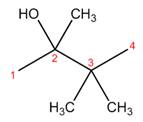
Explanation of Solution
The name of the given compound is
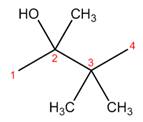
Figure 2
The structure corresponding to the given name is shown in Figure 2.
(c)
Interpretation: The structure corresponding to the given name is to be drawn.
Concept introduction: To derive the structure of the compound from its IUPAC name, one should follow the given three steps. The first step involves the identification of parent name and functional group found at the end of the name. The second step is numbering of carbon skeleton in either direction. The third step is addition of substituents at appropriate carbon atoms.
Answer to Problem 9.41P
The structure corresponding to the given name is,
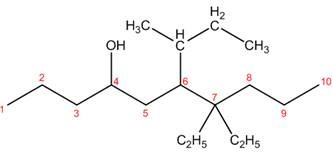
Explanation of Solution
The name of the given compound is

Figure 3
The structure corresponding to the given name is shown in Figure 3.
(d)
Interpretation: The structure corresponding to the given name is to be drawn.
Concept introduction: To derive the structure of the compound from its IUPAC name, one should follow the given three steps. The first step involves the identification of parent name and functional group found at the end of the name. The second step is numbering of carbon skeleton in either direction. The third step is addition of substituents at appropriate carbon atoms.
Answer to Problem 9.41P
The structure corresponding to the given name is,

Explanation of Solution
The name of the given compound is

Figure 4
The structure corresponding to the given name is shown in Figure 4.
(e)
Interpretation: The structure corresponding to the given name is to be drawn.
Concept introduction: To derive the structure of the compound from its IUPAC name, one should follow the given three steps. The first step involves the identification of parent name and functional group found at the end of the name. The second step is numbering of carbon skeleton in either direction. The third step is addition of substituents at appropriate carbon atoms.
Answer to Problem 9.41P
The structure corresponding to the given name is,
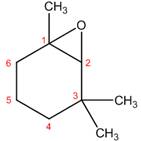
Explanation of Solution
The name of the given compound is

Figure 5
The structure corresponding to the given name is shown in Figure 5.
(f)
Interpretation: The structure corresponding to the given name is to be drawn.
Concept introduction: To derive the structure of the compound from its IUPAC name, one should follow the given three steps. The first step involves the identification of parent name and functional group found at the end of the name. The second step is numbering of carbon skeleton in either direction. The third step is addition of substituents at appropriate carbon atoms.
Answer to Problem 9.41P
The structure corresponding to the given name is,

Explanation of Solution
The name of the given compound is

Figure 6
The structure corresponding to the given name is shown in Figure 6.
(g)
Interpretation: The structure corresponding to the given name is to be drawn.
Concept introduction: To derive the structure of the compound from its IUPAC name, one should follow the given three steps. The first step involves the identification of parent name and functional group found at the end of the name. The second step is numbering of carbon skeleton in either direction. The third step is addition of substituents at appropriate carbon atoms.
The naming of chiral center and geometric isomers are based on Cahn-Ingold-Prelog priority rules. If the priority assigned to each group attached to the chirality center in a molecule is in a clockwise direction, then it is the R-stereoisomer, and if this is counter-clockwise, then it is the S-stereoisomer. R and S-stereoisomer are mirror images of each other.
Answer to Problem 9.41P
The structure corresponding to the given name is,
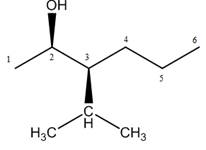
Explanation of Solution
The name of the given compound is

Figure 7
The structure corresponding to the given name is shown in Figure 7.
(h)
Interpretation: The structure corresponding to the given name is to be drawn.
Concept introduction: To derive the structure of the compound from its IUPAC name, one should follow the given three steps. The first step involves the identification of parent name and functional group found at the end of the name. The second step is numbering of carbon skeleton in either direction. The third step is addition of substituents at appropriate carbon atoms.
The naming of chiral center and geometric isomers are based on Cahn-Ingold-Prelog priority rules. If the priority assigned to each group attached to the chirality center in a molecule is in a clockwise direction, then it is the R-stereoisomer, and if this is counter-clockwise, then it is the S-stereoisomer. R and S-stereoisomer are mirror images of each other.
Answer to Problem 9.41P
The structure corresponding to the given name is,
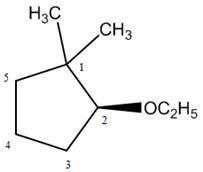
Explanation of Solution
The name of the given compound is

Figure 8
The structure corresponding to the given name is shown in Figure 8.
(i)
Interpretation: The structure corresponding to the given name is to be drawn.
Concept introduction: To derive the structure of the compound from its IUPAC name, one should follow the given three steps. The first step involves the identification of parent name and functional group found at the end of the name. The second step is numbering of carbon skeleton in either direction. The third step is addition of substituents at appropriate carbon atoms.
Answer to Problem 9.41P
The structure corresponding to the given name is,
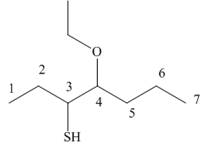
Explanation of Solution
The name of the given compound is
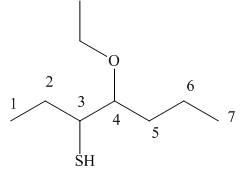
Figure 9
The structure corresponding to the given name is shown in Figure 9.
(j)
Interpretation: The structure corresponding to the given name is to be drawn.
Concept introduction: To derive the structure of the compound from its IUPAC name, one should follow the given three steps. The first step involves the identification of parent name and functional group found at the end of the name. The second step is numbering of carbon skeleton in either direction. The third step is addition of substituents at appropriate carbon atoms.
Answer to Problem 9.41P
The structure corresponding to the given name is,
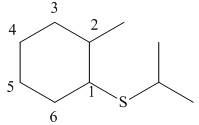
Explanation of Solution
The name of the given compound is

Figure 10
The structure corresponding to the given name is shown in Figure 10.
Want to see more full solutions like this?
Chapter 9 Solutions
Organic Chemistry-Package(Custom)
- Show the mechanism steps to obtain the lowerenergy intermediate: *see imagearrow_forwardSoap is made by the previous reaction *see image. The main difference between one soap and another soap isthe length (number of carbons) of the carboxylic acid. However, if a soap irritates your skin, they mostlikely used too much lye.Detergents have the same chemical structure as soaps except for the functional group. Detergentshave sulfate (R-SO4H) and phosphate (R-PO4H2) functional groups. Draw the above carboxylic acidcarbon chain but as the two variants of detergents. *see imagearrow_forwardWhat are the reactions or reagents used? *see imagearrow_forward
- The two pKa values of oxalic acid are 1.25 and 3.81. Why are they not the same value? Show the protontransfer as part of your explanation. *see imagearrow_forwardасть Identify all the bonds that gauche interact with C-OMe in the most stable conformation of the above compound.arrow_forwardPredict the reactants used in the formation of the following compounds using Acid-Catalyzed dehydration reactionarrow_forward
- Can I please get help with this?arrow_forward.. Give the major organic product(s) for each of the following reactions or sequences of reactions. Show ll relevant stereochemistry [3 ONLY]. A H Br 1. NaCN 2 NaOH, H₂O, heat 3. H3O+ B. CH₂COOH 19000 1. LiAlH4 THF, heat 2 H₂O* C. CH Br 1. NaCN, acetone 2 H3O+, heat D. Br 1. Mg. ether 3. H₂O+ 2 CO₂ E. CN 1. (CH) CHMgBr, ether 2 H₂O+arrow_forwardAssign this COSY spectrumarrow_forward
 ChemistryChemistryISBN:9781305957404Author:Steven S. Zumdahl, Susan A. Zumdahl, Donald J. DeCostePublisher:Cengage Learning
ChemistryChemistryISBN:9781305957404Author:Steven S. Zumdahl, Susan A. Zumdahl, Donald J. DeCostePublisher:Cengage Learning ChemistryChemistryISBN:9781259911156Author:Raymond Chang Dr., Jason Overby ProfessorPublisher:McGraw-Hill Education
ChemistryChemistryISBN:9781259911156Author:Raymond Chang Dr., Jason Overby ProfessorPublisher:McGraw-Hill Education Principles of Instrumental AnalysisChemistryISBN:9781305577213Author:Douglas A. Skoog, F. James Holler, Stanley R. CrouchPublisher:Cengage Learning
Principles of Instrumental AnalysisChemistryISBN:9781305577213Author:Douglas A. Skoog, F. James Holler, Stanley R. CrouchPublisher:Cengage Learning Organic ChemistryChemistryISBN:9780078021558Author:Janice Gorzynski Smith Dr.Publisher:McGraw-Hill Education
Organic ChemistryChemistryISBN:9780078021558Author:Janice Gorzynski Smith Dr.Publisher:McGraw-Hill Education Chemistry: Principles and ReactionsChemistryISBN:9781305079373Author:William L. Masterton, Cecile N. HurleyPublisher:Cengage Learning
Chemistry: Principles and ReactionsChemistryISBN:9781305079373Author:William L. Masterton, Cecile N. HurleyPublisher:Cengage Learning Elementary Principles of Chemical Processes, Bind...ChemistryISBN:9781118431221Author:Richard M. Felder, Ronald W. Rousseau, Lisa G. BullardPublisher:WILEY
Elementary Principles of Chemical Processes, Bind...ChemistryISBN:9781118431221Author:Richard M. Felder, Ronald W. Rousseau, Lisa G. BullardPublisher:WILEY





